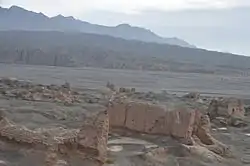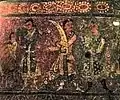Subashi Temple
The Subashi Temple is a ruined Buddhist temple near Kucha in the Taklamakan Desert, on the ancient Silk Road, in Xinjiang, Western China. The city was partly excavated by the Japanese archaeologist Count Otani.

Subashi Buddhist Temple Ruins - East Area

Subashi Buddhist Temple Ruins - West Area
Other famous sites nearby are the Kizilgaha caves, the Kumtura Caves, the Kizil Caves and the Simsim caves.[1]
A sarira, a Buddhist relic box of the 6th–7th century, discovered in Subashi shows Central Asian men in long tunics, reminiscent of other friezes which have been called Tocharian.
The "Witch of Subashi" is another famous archaeological artifact, the mummy of a woman with a huge pointed hat, thought to be a representative of early Caucasian populations who lived in the region around the beginning of our era.
 Sarira casket from Subashi. Wood covered with hemp and painted. 6th-7th century. Otani Collection. Tokyo National Museum.
Sarira casket from Subashi. Wood covered with hemp and painted. 6th-7th century. Otani Collection. Tokyo National Museum. Central Asian men, detail of Sarira box.
Central Asian men, detail of Sarira box. Central Asian men, detail of Sarira box.
Central Asian men, detail of Sarira box.
References
- (Other than Kizil)... "The nearby site of Kumtura contains over a hundred caves, forty of which contain painted murals or inscriptions. Other cave sites near Kucha include Subashi, Kizilgaha, and Simsim." in Buswell, Robert E.; Lopez, Donald S. The Princeton Dictionary of Buddhism. Princeton University Press. p. 438. ISBN 978-1-4008-4805-8.
External links
This article is issued from Wikipedia. The text is licensed under Creative Commons - Attribution - Sharealike. Additional terms may apply for the media files.